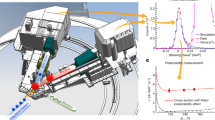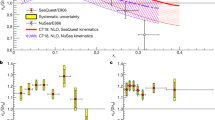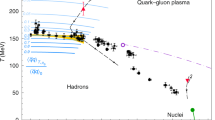Abstract
The proton is one of the main building blocks of all visible matter in the Universe1. Among its intrinsic properties are its electric charge, mass and spin2. These properties emerge from the complex dynamics of its fundamental constituents—quarks and gluons—described by the theory of quantum chromodynamics3,4,5. The electric charge and spin of protons, which are shared among the quarks, have been investigated previously using electron scattering2. An example is the highly precise measurement of the electric charge radius of the proton6. By contrast, little is known about the inner mass density of the proton, which is dominated by the energy carried by gluons. Gluons are hard to access using electron scattering because they do not carry an electromagnetic charge. Here we investigated the gravitational density of gluons using a small colour dipole, through the threshold photoproduction of the J/ψ particle. We determined the gluonic gravitational form factors of the proton7,8 from our measurement. We used a variety of models9,10,11 and determined, in all cases, a mass radius that is notably smaller than the electric charge radius. In some, but not all cases, depending on the model, the determined radius agrees well with first-principle predictions from lattice quantum chromodynamics12. This work paves the way for a deeper understanding of the salient role of gluons in providing gravitational mass to visible matter.
This is a preview of subscription content, access via your institution
Access options
Access Nature and 54 other Nature Portfolio journals
Get Nature+, our best-value online-access subscription
$29.99 / 30 days
cancel any time
Subscribe to this journal
Receive 51 print issues and online access
$199.00 per year
only $3.90 per issue
Buy this article
- Purchase on Springer Link
- Instant access to full article PDF
Prices may be subject to local taxes which are calculated during checkout



Similar content being viewed by others
Data availability
The raw data from the experiment are archived in the Jefferson Lab mass storage silo and at the Argonne National Laboratory. The analysed data are archived at the Argonne National Laboratory. The data are available in the Supplementary Information and a CSV file of the cross-section data is available in the Supplementary Data.
References
National Academies of Sciences, Engineering, and Medicine. An Assessment of U.S.-Based Electron-Ion Collider Science (The National Academies Press, 2018).
Particle Data Group. Review of particle physics. Prog. Theor. Exp. Phys. 2022, 083C01 (2022).
Shifman, M. A., Vainshtein, A. I. & Zakharov, V. I. QCD and resonance physics. Theoretical foundations. Nucl. Phys. B 147, 385–447 (1979).
Shifman, M. A., Vainshtein, A. I. & Zakharov, V. I. QCD and resonance physics. Applications. Nucl. Phys. B 147, 448–518 (1979).
Shifman, M. A., Vainshtein, A. I. & Zakharov, V. I. Remarks on Higgs-boson interactions with nucleons. Phys. Lett. B 78, 443–446 (1978).
Xiong, W. et al. A small proton charge radius from an electron–proton scattering experiment. Nature 575, 147–150 (2019).
Pagels, H. Energy-momentum structure form factors of particles. Phys. Rev. 144, 1250–1260 (1966).
Teryaev, O. V. Gravitational form factors and nucleon spin structure. Front. Phys. 11, 111207 (2016).
Kharzeev, D. E. Mass radius of the proton. Phys. Rev. D 104, 054015 (2021).
Guo, Y., Ji, X. & Liu, Y. QCD analysis of near-threshold photon-proton production of heavy quarkonium. Phys. Rev. D 103, 096010 (2021).
Mamo, K. A. & Zahed, I. Diffractive photoproduction of J/ψ and ϒ using holographic QCD: gravitational form factors and GPD of gluons in the proton. Phys. Rev. D 101, 086003 (2020).
Pefkou, D. A., Hackett, D. C. & Shanahan, P. E. Gluon gravitational structure of hadrons of different spin. Phys. Rev. D 105, 054509 (2022).
Wilson, K. G. Confinement of quarks. Phys. Rev. D 10, 2445–2459 (1974).
Dürr, S. et al. Ab initio determination of light hadron masses. Science 322, 1224–1227 (2008).
Borsanyi, S. et al. Ab initio calculation of the neutron-proton mass difference. Science 347, 1452–1455 (2015).
Hatta, Y. & Yang, D.-L. Holographic J/ψ production near threshold and the proton mass problem. Phys. Rev. D 98, 074003 (2018).
Hatta, Y., Rajan, A. & Tanaka, K. Quark and gluon contributions to the QCD trace anomaly. J. High Energy Phys. 12, 8 (2018).
Hatta, Y., Rajan, A. & Yang, D.-L. Near threshold J/ψ and ϒ photoproduction at JLab and RHIC. Phys. Rev. D 100, 014032 (2019).
Mamo, K. A. & Zahed, I. J/ψ near threshold in holographic QCD: A and D gravitational form factors. Phys. Rev. D 106, 086004 (2022).
Ji, X., Liu, Y. & Zahed, I. Mass structure of hadrons and light-front sum rules in the ’t Hooft model. Phys. Rev. D 103, 074002 (2021).
Sun, P., Tong, X.-B. & Yuan, F. Perturbative QCD analysis of near threshold heavy quarkonium photoproduction at large momentum transfer. Phys. Lett. B 822, 136655 (2021).
Ji, X. Proton mass decomposition: naturalness and interpretations. Front. Phys. 16, 64601 (2021).
Ji, X. & Liu, Y. Quantum anomalous energy effects on the nucleon mass. Sci. China Phys. Mech. Astron. 64, 281012 (2021).
Lorcé, C., Metz, A., Pasquini, B. & Rodini, S. Energy-momentum tensor in QCD: nucleon mass decomposition and mechanical equilibrium. J. High Energy Phys. 2021, 121 (2021).
Duran, B. The J/ψ-007 Experiment: A Search for the LHCb Charm Pentaquarks in Hall C at Jefferson Lab. PhD thesis, Temple Univ. (2021).
Ali, A. et al. First measurement of near-threshold J/ψ exclusive photoproduction off the proton. Phys. Rev. Lett. 123, 072001 (2019).
Mamo, K. A. & Zahed, I. Nucleon mass radii and distribution: holographic QCD, lattice QCD and GlueX data. Phys. Rev. D 103, 094010 (2021).
Hou, T.-J. et al. New CTEQ global analysis of quantum chromodynamics with high-precision data from the LHC. Phys. Rev. D 103, 014013 (2021).
Alexandrou, C. et al. Complete flavor decomposition of the spin and momentum fraction of the proton using lattice QCD simulations at physical pion mass. Phys. Rev. D 101, 094513 (2020).
Yang, Y.-B. et al. Proton mass decomposition from the QCD energy momentum tensor. Phys. Rev. Lett. 121, 212001 (2018).
Shanahan, P. E. & Detmold, W. Gluon gravitational form factors of the nucleon and the pion from lattice QCD. Phys. Rev. D 99, 014511 (2019).
Wang, R., Chen, X. & Evslin, J. The origin of proton mass from J/Ψ photo-production data. Eur. Phys. J. C 80, 507 (2020).
Kharzeev, D. Quarkonium interactions in QCD. Proc. Int. Sch. Phys. Fermi 130, 105–131 (1996).
Kharzeev, D., Satz, H., Syamtomov, A. & Zinovjev, G. J/ψ photo-production and the gluon structure of the nucleon. Eur. Phys. J. C 9, 459–462 (1999).
Bosted, P. E. & Christy, M. E. Empirical fit to inelastic electron-deuteron and electron-neutron resonance region transverse cross sections. Phys. Rev. C 77, 065206 (2008).
Gryniuk, O., Joosten, S., Meziani, Z.-E. & Vanderhaeghen, M. ϒ photoproduction on the proton at the electron-ion collider. Phys. Rev. D 102, 014016 (2020).
D’Agostini, G. A multidimensional unfolding method based on Bayes’ theorem. Nucl. Instrum. Methods Phys. Res. A 362, 487–498 (1995).
Pauk, V. & Vanderhaeghen, M. Lepton universality test in the photoproduction of e−e+ versus μ−μ+ pairs on a proton target. Phys. Rev. Lett. 115, 221804 (2015).
Mathieu, V. et al. Vector meson photoproduction with a linearly polarized beam. Phys. Rev. D 97, 094003 (2018).
Ji, X. QCD analysis of the mass structure of the nucleon. Phys. Rev. Lett. 74, 1071–1074 (1995).
He, F., Sun, P. & Yang, Y.-B. Demonstration of the hadron mass origin from the QCD trace anomaly. Phys. Rev. D 104, 074507 (2021).
Acknowledgements
This work was supported in part by the US Department of Energy Office of Science, Office of Nuclear Physics, under contract numbers DE-AC02-06CH11357 and DE-FG02-94ER40844, and contract number DE-AC05-06OR23177, under which Jefferson Science Associates operates the Thomas Jefferson National Accelerator Facility.
Author information
Authors and Affiliations
Contributions
S. Joosten, M.K.J., Z.-E.M., M.P. and E.C. are joint spokespersons for the experiment. The data analysis was carried out by B.D., S.J., M.K.J., S.P., C.P. and Z.-E.M. All authors reviewed the manuscript. The entire J/ψ-007 collaboration participated in the data collection and in the online analysis of the experiment.
Corresponding author
Ethics declarations
Competing interests
The authors declare no competing interests.
Peer review
Peer review information
Nature thanks the anonymous reviewers for their contribution to the peer review of this work.
Additional information
Publisher’s note Springer Nature remains neutral with regard to jurisdictional claims in published maps and institutional affiliations.
Extended data figures and tables
Extended Data Fig. 2 Mass radius and trace anomaly.
Left panel: The extracted radius as a function of the photon energy according to ref. 9 together with the GlueX result. Both our and the GlueX extractions used a dipole fit of the form factor. The charge radius from CODATA and the latest electron scattering6 (labeled PRad) are plotted as lines with error bands. The lattice result12 is plotted as a grey line with grey error band. Right panel: The extracted Ma/M according to Ji’s mass decomposition40 following32 along with a recent direct lattice calculation of the same quantity41.
Supplementary information
Supplementary Information
This file contains Supplementary Figs. 1–12, Supplementary Tables 1–8 and references.
Supplementary Data
CSV file and legend with the two-dimensional cross-section results.
Rights and permissions
Springer Nature or its licensor (e.g. a society or other partner) holds exclusive rights to this article under a publishing agreement with the author(s) or other rightsholder(s); author self-archiving of the accepted manuscript version of this article is solely governed by the terms of such publishing agreement and applicable law.
About this article
Cite this article
Duran, B., Meziani, ZE., Joosten, S. et al. Determining the gluonic gravitational form factors of the proton. Nature 615, 813–816 (2023). https://doi.org/10.1038/s41586-023-05730-4
Received:
Accepted:
Published:
Issue Date:
DOI: https://doi.org/10.1038/s41586-023-05730-4
This article is cited by
-
A glimpse at the inner structure of the proton
Nature (2023)
-
Femtoscopy of the Matter Distribution in the Proton
Few-Body Systems (2023)
Comments
By submitting a comment you agree to abide by our Terms and Community Guidelines. If you find something abusive or that does not comply with our terms or guidelines please flag it as inappropriate.



